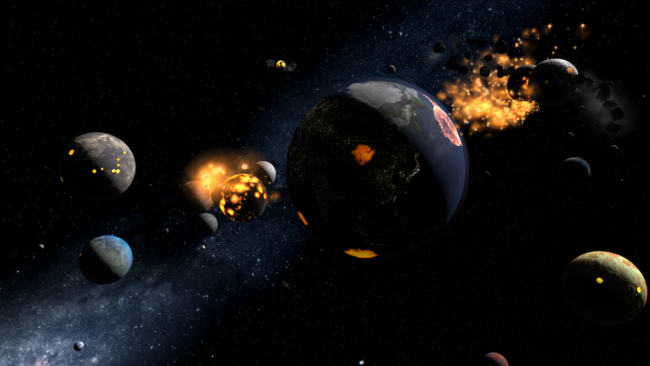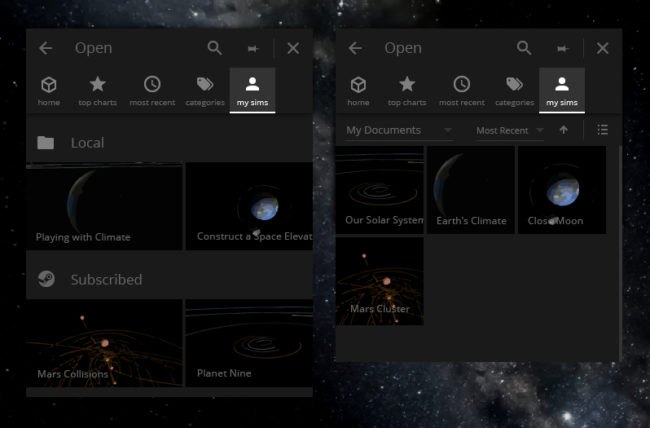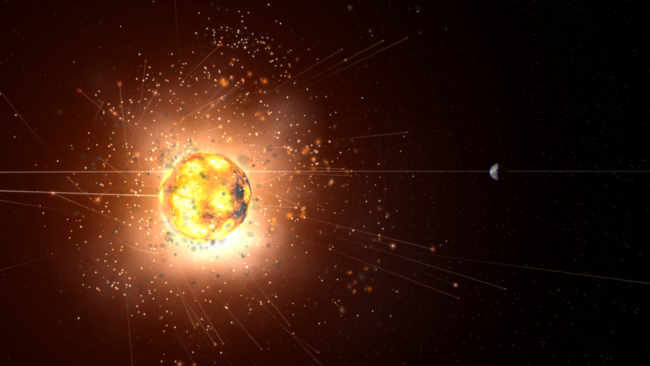Universe Sandbox ² Updated 2017 Roadmap

What’s Completed
At the beginning of this year, we shared Part I and Part II of our roadmap for 2017. We’ve now well past the halfway point, so it’s time for an update on what we’ve accomplished so far and we’ve got our sights set on for the rest of 2017 and into next year.
A New Foundation & VR 2.0 | Update 20
This was a big update for us, with a lot of important behind-the-scenes changes and a big list of VR improvements. Below are some of the highlights from this update; check out the Update 20 post for more information on how it’s paving the way for some bigger changes down the road.
- Rewritten, Scalable User Interface
- With our rewritten user interface, you can now scale the interface for smaller and larger resolutions.
- Future support for on-the-fly switching between multiple languages (see below).
- New Code Architecture
- A major reorganization that will make it easier for us to maintain our code, track down bugs, and develop and iterate on features.
- VR added Disintegration, Teleportation, and a Lot More
- Added all the new simulation features, improvements, and fixes from the Disintegration desktop updates, including…
- Tidal forces
- Improved explosions, and…
- New fragment and particle system
- A completely rewritten locomotion system for more responsive and smoother panning, scaling, and the all new rotation
- Teleportation! It’s never been easier to move from one planet to another
- Added all the new simulation features, improvements, and fixes from the Disintegration desktop updates, including…
Update 20 also included a long list of smaller improvements and bug fixes. And in the past couple of months since its release, we’ve pushed out smaller patches with many more bug fixes, plus the eclipse update below.
Solar Eclipse | Update 20.1
You probably heard about the August 21 solar eclipse that was visible from all of North America. We hope you were able to see it in person! But if you weren’t able to, or if you just want to see it over and over again now, then we’ve got just the simulation for you. See the Update 20.1 blog post for more info.
- August 21, 2017 Total Solar Eclipse Simulation
- Home > Open > Total Solar Eclipse on August 21, 2017
- A simulation of the Moon passing between the Sun and Earth and blocking out light across North America.
- Shadow Improvements
- Using past eclipse images as a guide, we’ve tweaked shadows just a bit to better capture Moon’s shadow on Earth.
- Advance Time Feature
- Introduced in 20.1.1, this feature allows you to run the sim until a specified length of time has passed. Just click the timer in the bottom bar to set a date or length of time then click Start!
What’s Coming Next
The following list is in a very rough order. These are all things we are working on currently, but when they’ll arrive is difficult to predict. If we had to guess when we’ll first start seeing them, we’d have to simply say “soon.”
Planet Grids
A debugging tool we are using to test the new planet grids. This tool shows how temperature is broken down into data points across the surface of the planet.
Planet Grids (previously called “automata”) is a new piece of tech that we’ve been working on for a while now that we’re very excited to introduce. The first stage of this tech allows us to simulate localized temperatures across surfaces, rather than an average temperature for the whole object. In turn, this will allow for much more dynamic and detailed visuals and simulation. This is also a crucial first step for another feature that’s long been coming…
Lasers
Lasers are fun for everyone! We’re very excited about introducing these, but it’s possible the community is even more excited. We don’t blame you. Good news: the laser is coming soon to the desktop version and will simultaneously return to VR with improved realism and functionality.
- From Laser Pointer to Planet Destroyer
- Set the power of the laser to go from a realistically-powered laser pointer to a laser far more powerful than anything ever produced, one capable of melting all of the ice off of Earth and heating it up to the point of complete vaporization.
Stellar Evolution
We unfortunately had to push this out of the Update 20 release because it simply took longer than expected and was not finished. The model itself is complete, but removing the old model and replacing it with the new is no simple task. Once we’ve got it plugged in, we’ll need to thoroughly test it to make sure that everything is in good shape and working as expected. This also is no simple task (there are many variables when it comes to testing stellar evolution in a universe simulator), but we’re definitely nearing completion.
- A Rewritten Model for the Life of a Star
- The new model supports 16 evolutionary star types versus the previous 5. It is primarily a function of mass and age or metallicity, and will work for evolutionary types outside of main-sequence stars.
- The results will be more dynamic and accurate properties for stars, as well as smoother transitions from type to type. It will also support mass loss from solar winds, and be able to differentiate envelope from core.
Steam Workshop

Early design mock-up of a new interface for with support for Steam Workshop simulations.
We’ve just begun work on adding Steam Workshop support to Universe Sandbox ². There’s plenty to do on the design front, and we have kinks to work out with our save & load system, but all things considered, we’re making good progress. Steam Workshop support is often requested by the community, and for good reason — we’re very excited to see what happens once it becomes easy to explore all of the simulations and scenarios the community is creating… and destroying.
- Share Simulations & Objects with the Whole Community
- Space may be a vacuum, but that doesn’t mean you should feel like you’re living in one in Universe Sandbox ². With support for Steam Workshop, you can easily browse, vote on, download, and explore community-created sims and objects, and of course upload your own for the whole community to check out.
- And Eventually, Share Models & Textures Too
- The first iteration will likely only support custom sims and saved objects, but in the future (see below) we plan to add support for custom models and textures as well.
Faster Physics & Performance
Thomas, our physics programmer, has made substantial upgrades to the physics code more times than we can count. But whatever number that is, add one more. We’re extremely grateful for every improvement, as physics is at the core of Universe Sandbox ², and making it faster means a lot more than just simply adding on a few FPS.
- Rewritten Physics Code
- A smoother user experience, more stable simulations at higher time steps, and more room for all of the big, new physics features we’re working toward, such as rigid body collisions, total body fragmentation, and space megastructures.
And Then Into 2018…
Localization
- Supported by New User Interface
- Now that our new user interface is in Universe Sandbox (Update 20), we’re ready to add the localization system.
- Community-Sourced Translations
- We plan to ask you, the community, for help in translating all of the text in Universe Sandbox ². We’re not certain how it will work yet, but our ideal system will let you click on any snippet of text from within Universe Sandbox ² and offer a translation or an improvement on an existing translation.
- Switch On-the-Fly Between Multiple Languages
- You’ll be able to switch at any moment between available translations. What is available depends on the community — as long as one user has offered translations, then it will be available for everyone to use and improve upon.
Custom Models
- Import Models & Textures Created by You or the Community
- This is in some ways the second big part of the Steam Workshop support. Being able to browse and download community-made models and textures which you can use in Universe Sandbox ² is going to help a lot with all of the requests we get for fictional and real spacecraft and planets. Of course, custom models means you can import whatever model you like (limited by file type), so if you’d prefer a cow over a rocket ship, then that’s okay too.
Rigid Body Collisions
- Bouncing and Breaking Apart Human Sized Objects
- Right now, human sized objects in Universe Sandbox ², like dice or bowling balls, will combine when they collide. Rigid body physics will make these collisions much more realistic, so they’ll instead “bounce” off of each other as you would expect them to.
- And Don’t Forget Stacking and Connecting
- Bouncing only makes sense some of the time for rigid body collisions. If you’re on the surface of a planet, for example, then you should also be able to stack these objects. Where does connecting come into this? Well, if you have rocket parts, then those should probably snap together… But we’re still far away from this.
Total Body Fragmentation
- Kaboom!
- With this new system, bodies will completely fragment when the force of a collision is strong enough. This should be most apparent when two equally sized bodies collide, as they should completely fragment apart instead of one “eating” the other, which currently happens.
More Advanced Planet Grids
- More Detailed and Responsive Planet Visuals & Interactions
- The first iteration of Planet Grids which is arriving along with lasers will help with temperature, but eventually the system will become more complex and allow for more advanced simulation, such as freeze heights, improved molten visualization, and…
- ???
- It’s hard to say what Planet Grids has in store for us next. Heat transfer between planetary layers? Life simulation? Maybe! We don’t have an exact plan, but we’re excited by all of the possibilities that open up with Planet Grids.

And Into the Distant Future
Mobile Version
- Universe Sandbox ² on Your Phone and Tablet
- Universe Sandbox ² is all about asking fantastical what-if questions. Well, what if you could simulate the universe on your phone? Our guess is you’d probably be pretty happy. At least, that’s what’s been proven true so far whenever we run a test build on our mobile devices. There are many user interface challenges still to solve, but we’re making good progress on this mobile version.
Space Megastructures
- Megastructures, But in Space
- We mention these a lot, even though they’re not on the immediate horizon, because they’re just that exciting to think about. Using physics-based space tethers as the idea behind the basic building block, these structures can come in many pre-defined shapes and sizes, and eventually support building custom structures.
- Think space elevators, Dyson spheres, and ring worlds. And then squeal with joy (and patience).
There isn’t a single item on this list that doesn’t get us excited. We’re happy with how far we’ve already come with Universe Sandbox ², and now we’re itching to see where these new features take us and our fans. There will soon be even more tools for creating and exploring whatever you can imagine, and you’ll have the ability to share these with the entire community, a community that will expand with localization and the mobile version. Many thanks to our ever-growing community of fans for all of your support.
For the latest Universe Sandbox ² news, follow us on Twitter and Facebook.

about 7 years ago
I’ve been waiting for years to see this on the iPad. Will this be a full featured conversion from the PC or a diluted version?
about 7 years ago
Our intention is to have the mobile version on par with the desktop version. There may be some necessary performance and graphical differences due to hardware limitations, but the features will hopefully be very much the same. 🙂
about 7 years ago
i cannot wait will it be free for mobile
about 7 years ago
We have not decided on pricing yet for a mobile version of Universe Sandbox ², but it will likely not be free.
about 7 years ago
about 7 years ago
add wormholes
about 7 years ago
about 7 years ago
WOW, I am very excited about total bodt fragmantiaton, but how I imagnie that my i7 6700 will not keep up, how is it going to work?!
about 7 years ago
Add life simulation and add a small chance that your life could bring the planet to its end through nuclear winter or global warming
about 7 years ago
We plan to implement basic life simulation that, at least at first, would allow vegetation to grow under the right conditions. Maybe more advanced life simulation will come in the distant future. 🙂
about 7 years ago
I’d love it if you were able to adjust the chemical composition of the planets. God, I would pretty much do anything for that. …..Anything. Just sayin’
about 7 years ago
And by that, I mean: their atmospheres. So much work went into weather…well…chemicals are the atmosphere. They influence weather. Come on guys, don’t make me beg.
about 7 years ago
Atmospheric composition is something we’ve discussed and we’d love to simulate it in the future. It’s a complex task, though, and is not currently high priority for us. Thanks for your feedback!
about 6 years ago
Will we get accretion disks that eventually form new stars when we explode a very large star? (super nova)
about 6 years ago
Also to be able to add oort clouds and kepier belt objects around stars would be cool
about 5 years ago
I think the thing I would love to see most is the rigid-body structures and the Planet grids finished. 🙂